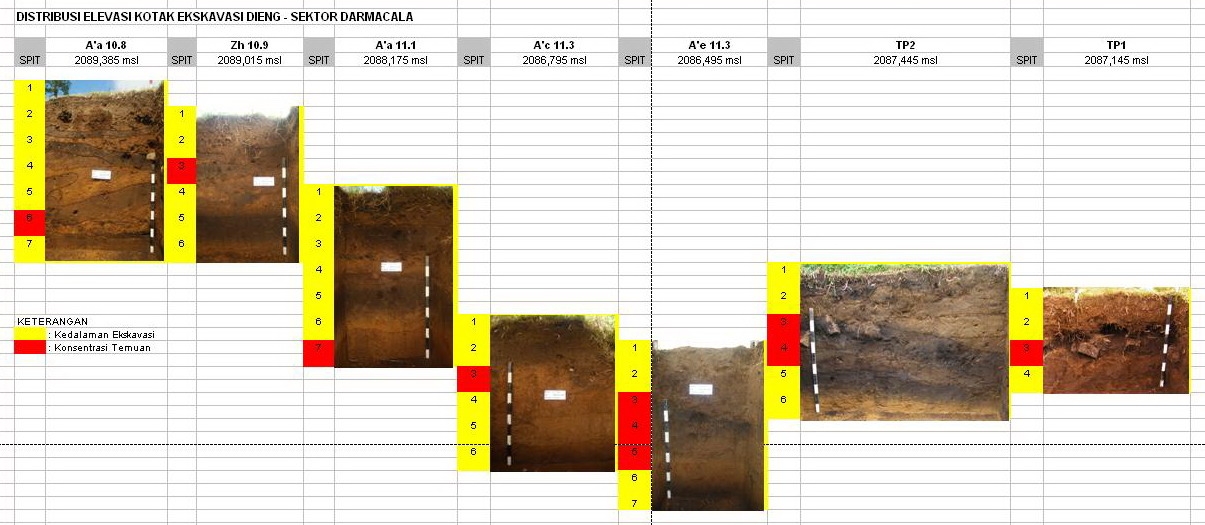Three units were excavated in this sector: K’f 32.1 and K’b 32.4 which were located near each other, and unit Zh 109.
The site for unit K’f 32.1 was chosen because it was near the old well in the Dharmasala complex; local residents reported ceramic finds in the area; and a Dusun jar sherd was found on the surface in the vicinity of the Dharmasala complex.
The surface of unit K’f 32.1 was covered by grass and plastic trash. The excavation began from corner T1 (the highest point of the ground surface). When excavating Spit 1, water began to seep into the unit. The only finds were fragments of modern glass (11) and a modern porcelain plate. During the excavation of spit 2, water started to pour in and flooded the unit. A water pump had to be employed to continue the excavation. Artifacts found in spit 2 also consisted of glass and modern ceramics. The excavation was continued to a depth of 38 cm from the modern ground surface, at which point it had to cease because the flow of water was so strong that it could not be pumped out as quickly as it flowed into the pit. The two layers of earth which were exposed comprised an upper layer of dark chocolate color and a lower layer which had a brownish yellow color.

Details of the finds are listed in the table below:
Dataset: Chinese Ceramics
Dataset: Glass
Showing 0 of 0 total records in this dataset. See all.
Unit K’b32.4
Reasons for choosing unit K’b 32.4: it was near an old well in the Dharmasala complex, local residents reported ceramic finds, and a Dusun jar sherd was found nearby. The precise location of the unit was right next to a structure around an old well (see drawing 1).
The surface of the unit before excavation was a grass-covered slope inclined downward toward the south. SDP was 20 cm from the surface at corner T1. Spit 1 was set at 25 cm from the ground surface (45 cm from the SDP). At this depth were found plastic trash, glass fragments, modern ceramics, and earthenware fragments. The end of spit 2 was set at 75cm from SDP. The same variety of finds was found in spit 2. The bottom of spit 3 was set at approximately 100 cm from SDP. At this depth, the unit filled with water so quickly that it was difficult to dig further. No stratification was visible.
Finds are listed in the following table:
Dataset: Porcelain and earthenware
Showing 0 of 0 total records in this dataset. See all.
Dataset: Glass
Showing 0 of 0 total records in this dataset. See all.
Unit ZH10.9 Finds
Square Zh10.9 was excavated on the basis of local information that many ceramic sherds had been discovered in the vicinity of Darmacala and an old well. The square was located at 2089.215 m asl. The square was excavated to spit 7 (70 cm from local datum point). Finds were recovered until spit 5.
Details of finds are as follow:
Dataset: Table 2-5
Showing 0 of 0 total records in this dataset. See all.
Dataset: Ancient Earthenware
Showing 0 of 0 total records in this dataset. See all.
Dataset: Modern
Showing 0 of 0 total records in this dataset. See all.
The Dharmasala sector yielded useful information from the lowest spit, consisting of a number of ancient Javanese earthenware. Unfortunately it was not possible to excavate further in this sector due to the high level of the water table. Excavation had to be halted and shifted to another sector. It is unlikely that further excavations can be carried out in the Dharmasala sector unless the drainage system of the plateau is changed, but that would damage the livelihoods of the farmers who depend on the water for their crops.